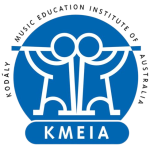
Musicianship: Level 5
Day 2
Musicianship: Level 7/8 (Advanced studies)
- Presentation: Awards for Excellence in Australian Kodály-inspired Music Education
- Conference Choir Rehearsal – Tracy Wong & Mark O’Leary
All conference delegates will form part of the 2024 Conference Choir, led by renowned conductors Tracy Wong (Canada/Malaysia) and Mark O’Leary OAM. The choir will rehearse two pieces, including a new conference commission by Juliana Kay, and perform at the choir concert on the Wednesday evening.
- ‘Junggara Pelican’: Learn to sing and dance the pelican’s song (and other First Nations song materials) – Candace Kruger
- Embracing a multi-modal approach in the lower primary music classroom – Tammy Kilpatrick
- Burgundy Blue: Teaching Through Jazz A Cappella
- All Means All: The Inclusive Music Room – Katherine Smith
- Fun and Games in the Secondary Classroom – Joel Copeland
- Research: Narratives of young adolescents’ musical flourishing in Kodály-inspired class music education – Jason Goopy
- Research: “That wouldn’t work at this school”: Influences of a music teacher’s enacted pedagogy – Ailsa Harris
‘Junggara Pelican’: Learn to sing and dance Yugambeh language songs, in particular the Pelican’s song.
As music educators we can embrace a multimodal approach in the classroom. By prioritising play-based activities that incorporate movement and visuals in conjunction with the aural stimulus, we can maximise engagement and scaffold learning and assessment for all students.
Concepts such as beat and rhythm, high and low, quiet and loud, must first be experienced through movement. Children may unconsciously keep the beat and perform the rhythm as they move to music. They may show the pitch of a melody as they playfully enact a song’s text. Expressive devices arise innately in games and creative movement, giving meaning and purpose to the play.
Visual representation of concepts can deepen understanding. Children may use their bodies to physically represent the rhythm. They may incorporate props to isolate musical elements. Concepts can be further scaffolded through visual means, including manipulatives, flash cards and word walls, with many opportunities to practice concepts before assessing student learning.
This interactive workshop will focus on the prepare and practice stages of the Kodály-inspired teaching methodology, including student assessment. Ideas for classroom organisation and visual displays will also be shared. The resources and activities presented will be suitable for 5–8-year-olds.
What can students learn from jazz a capella singing? In this workshop, jazz a cappella quintet Burgundy Blue will share some activities and ideas from their years of performing and running workshops. Integrating forms of vocal play, vocal percussion, and close harmony singing, these activities are aimed at encouraging student risk-taking, building confidence and teaching musicianship in a group music-making context.
